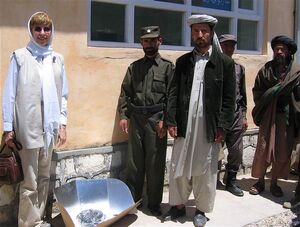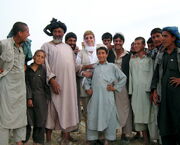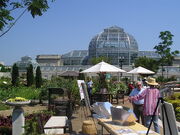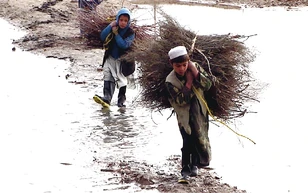Solarwind1 (talk | contribs) |
Solarwind1 (talk | contribs) |
||
| Line 43: | Line 43: | ||
==News and recent developments== |
==News and recent developments== |
||
| − | *'''January 2010:''' [[Pat McArdle]] |
+ | *'''January 2010:''' [[Pat McArdle]] joins the Global Alliance for Clean Cookstoves working group on Fuels and Technology. |
*'''October 2010:''' [[Pat McArdle]] is interviewed by the Voice of America about [[Solar Cookers International]]'s participation at a disaster relief technology gathering held recently in Washington D.C. The goal is to be able to share information for quicker response times with aid, when natural disasters occur. |
*'''October 2010:''' [[Pat McArdle]] is interviewed by the Voice of America about [[Solar Cookers International]]'s participation at a disaster relief technology gathering held recently in Washington D.C. The goal is to be able to share information for quicker response times with aid, when natural disasters occur. |
||
| − | [[Video:Disaster Relief Technology|thumb|300px|[[Pat McArdle]] interviewed about disaster relief technology.]] |
+ | [[Video:Disaster Relief Technology|thumb|left|300px|[[Pat McArdle]] interviewed about disaster relief technology.]] |
| + | |||
| ⚫ | |||
| + | |||
| + | |||
| + | |||
| + | |||
| + | |||
| + | |||
| + | |||
| + | |||
| + | |||
| + | |||
| + | |||
| + | |||
| + | |||
| + | |||
| ⚫ | |||
| + | *[[File:Farishta,_a_novel.jpg|thumb|left]]] |
||
[[File:White_Horse_HS.jpg|250px|left]] |
[[File:White_Horse_HS.jpg|250px|left]] |
||
| + | |||
| + | |||
| + | |||
| + | |||
| + | |||
| + | |||
| + | |||
| + | |||
| + | |||
| + | |||
| + | |||
| + | |||
| + | |||
| + | |||
| + | |||
| + | |||
| + | |||
*'''May 2010:''' Utah-based Adopt-a-Native Elder asked me to join one of their food runs to the Navajo reservation to make a series of presentations on solar cooking. I discovered that in the winter when roads are closed by deep snow and propane runs out, many Navajos cut down trees for firewood. In the summer when it's too hot to cook indoors, it is common to light a wood fire outside for cooking. Sunshine is abundant and despite "no cutting down trees" warnings in the national parks, I saw hillsides that had been stripped of their trees and thousands of acres formerly covered with juniper and pinyon trees that are now barren desert. The Navajos who saw the solar cookers and ate my chili and corn bread were intrigued by these devices. Twenty volunteers took the different models home and agreed to keep a one month log of solar cooker use. A family of sheepherders took several Cookits, which are light enough to strap to their saddles for long trips into the mountains. We have already heard from one satisfied customer, a Navajo rug weaver, who slaughtered a sheep for a family event and roasted a chunk of the meat in his Sun Oven. I also met a group of Navajo students at White Horse High School in Montazuma Creek, Utah, who have constructed a fresnel lens solar cooker for making fry bread. They were finalists in the national Spirit of Innovation Award. Their science teacher Paul McCarl is hoping to manufacture more of these cookers that his students can demonstrate at local gatherings during the summer. |
*'''May 2010:''' Utah-based Adopt-a-Native Elder asked me to join one of their food runs to the Navajo reservation to make a series of presentations on solar cooking. I discovered that in the winter when roads are closed by deep snow and propane runs out, many Navajos cut down trees for firewood. In the summer when it's too hot to cook indoors, it is common to light a wood fire outside for cooking. Sunshine is abundant and despite "no cutting down trees" warnings in the national parks, I saw hillsides that had been stripped of their trees and thousands of acres formerly covered with juniper and pinyon trees that are now barren desert. The Navajos who saw the solar cookers and ate my chili and corn bread were intrigued by these devices. Twenty volunteers took the different models home and agreed to keep a one month log of solar cooker use. A family of sheepherders took several Cookits, which are light enough to strap to their saddles for long trips into the mountains. We have already heard from one satisfied customer, a Navajo rug weaver, who slaughtered a sheep for a family event and roasted a chunk of the meat in his Sun Oven. I also met a group of Navajo students at White Horse High School in Montazuma Creek, Utah, who have constructed a fresnel lens solar cooker for making fry bread. They were finalists in the national Spirit of Innovation Award. Their science teacher Paul McCarl is hoping to manufacture more of these cookers that his students can demonstrate at local gatherings during the summer. |
||
[[File:Google_031.jpg|thumb|left|162px]] |
[[File:Google_031.jpg|thumb|left|162px]] |
||
Revision as of 13:23, 17 February 2011

Patricia McArdle, an advocate of sustainable, renewable energy and a volunteer promoter of integrated solar thermal cooking technology, is a member of the board of directors of Solar Cookers International. In her public lectures and demonstrations she argues that the widespread use of this simple technology will dramatically improve the lives of the hundreds of millions of women and children who must travel miles from their villages to gather wood every week. Using solar cookers in combination with fuel efficient stoves and retained heat cookers will also dramatically reduce deforestation and CO2 emissions. Cooking and pasteurizing water with the sun can prevent millions of deaths each year from diseases caused by drinking contaminated water and by inhaling the smoke of cooking fires. McArdle has more than 30 years of international and public affairs experience. Her novel Farishta, based on the year she spent in northern Afghanistan will be published by Riverhead Books on June 2, 2011
Background
Patricia served as a Peace Corps volunteer health educator in Paraguay in the early 1970s then joined the U.S. Navy where she spent three years at a remote communications base in Morocco. After 27 years as a U.S. diplomat, she left government service in 2006. Her last overseas assignment was as the Department of State's senior representative at a British Army-run Provincial Reconstruction Team in Northern Afghanistan. Here in her own words is the story of her "solar cooker epiphany".
"I had heard of solar cookers before I went to Afghanistan, but I knew little about them or their incredible potential to save forests, reduce indoor air pollution and improve the lives of millions of women.

Patricia McArdle demonstrating her homemade Cookit to the governor, chief of police and villagers of Marmol in Balkh Province, Northern Afghanistan in March 2005
My solar cooker epiphany occurred on a cold but sunny March day while on patrol in the Hindu Kush with one of our military observation teams. During my travels around northern Afghanistan, I had observed that there were almost no trees and little groundcover left in the region. People told me that the trees had been cut down for firewood or to make charcoal. As we drove that morning up a narrow mountain trail to a remote village for a meeting with local officials, we passed a group of young (five to seven year old) children leading donkeys down the trail.
After our meeting, the soldiers and I were given a tour of the village. The district governor showed us the one remaining “forest” in the area, a small grove of cedar and pine growing just above the village. It was guarded night and day to prevent the trees from being cut down for firewood. The governor explained to us that if they lost their “forest,” the next big rain would wash away the village. I was also invited into one of the family compounds and introduced to the women who were cooking lunch over a smoky fire fueled with what looked like tumbleweed stacked in a huge pile next to their mud-walled hut.
At the end of the day, heading down the mountain, we again passed the children, who were on their way home. They were struggling to carry enormous bundles of the same “tumbleweed” I had seen the women cooking with. As we traveled west into the glare of the setting sun, I suddenly remembered the solar cooker I had constructed out of a cardboard box when I was a Girl Scout many years ago. “Someone should tell these people about solar cookers,” I thought. Since I didn’t know much about solar cookers myself, I did some research.
That night, back at our camp in Mazar-e Sharif, I trolled the Internet for information on solar cookers and found the Solar Cooking Archive, managed by Solar Cookers International. I spent the next few evenings learning about this remarkably simple technology. Eventually I downloaded several plans, and asked the British Army field kitchen staff for some old cardboard boxes, aluminum foil and flour to make paste. With the help of the soldiers, I constructed five different box- and panel-type solar cookers. We took them up to the roof of our heavily guarded compound and, over a period of several weeks, tested them and measured the results. The solar CooKit won the competition.
It was clear to me that there was a great potential in this country for the widespread distribution of solar cookers to:
- Reduce the amount of time children spend foraging for fuel
- Reduce erosion caused by a lack of ground cover (and the resulting flooding)
- Cut down on the amount of smoke that women are exposed to while cooking
I hoped to return eventually to the village that had inspired me to learn about solar cookers, demonstrate the CooKit, and see how the people would react to this remarkable technology. Several months later, we went back.
It was another cool, sunny day. A small group of men standing in front of the governor’s compound watched in silence as we arrived for our meeting. (Women are not allowed out in public unless the gathering is all female). Before going in to see the governor, I poured a bottle of water into a black pot, put the pot inside a transparent oven (turkey) bag, placed the bag in my homemade CooKit, turned the CooKit to face the sun and went inside with the soldiers.

When we came out of the meeting 90 minutes later, the pot was steaming and the crowd had swelled from 10 to about 40 men. They were scratching their beards, pointing at the CooKit and trying to figure out how this piece of cardboard covered with shiny paper was able to boil water. Where was the fire? It looked to them like magic even after I explained how it worked. The pot was clearly very hot, but the cardboard and aluminum foil were not. How could this be? They all insisted on coming up to touch the very hot pot and then the cool foil-covered cardboard to confirm what they were seeing.
One of the men exclaimed, “We could make our tea with this!” The others nodded enthusiastically. Another said he would be able to find cardboard, but “where,” he asked, “do I get that shiny paper?” They all looked at me in silence, waiting for an answer. I wasn’t certain how to reply, because I knew that aluminum foil was not sold anywhere but Kabul, which was more than 100 miles to the south over the Hindu Kush.
Another man smiled, reached into his back pocket and took out a pack of cigarettes. He pulled up the inner foil liner and shouted, “We could use this!” The other men nodded, and several more pulled out their own cigarette packs to examine the foil liners. Within five minutes, these men had figured out a use for this technology and they had discovered a way to manufacture it using a locally available resource. None of them suggested that their wives might be able to cook meals with this technology, but I was still very impressed with their positive and creative reaction to my very brief demonstration. If they only used the CooKit for heating tea water, they would still dramatically reduce the biomass consumption of their village.
I began inquiring about solar cooker projects in Afghanistan and found that only Gordon Magney and his wife Grace, who had taught Afghan women to use several thousand SPORT solar box cookers, were the only people involved with the promotion of solar cookers. (I learned later that Sun Ovens International had, several years earlier, also distributed solar cookers in Afghanistan.) Magney gave me a detailed proposal for another solar cooker project. I tried to generate support for his project within our embassy and U.S. Agency for International Development (USAID) mission, but, sadly, was not successful. There are a few other dedicated individuals including Grace Magney still promoting solar cooking in Afghanistan. Grace assisted me with a report I prepared in 2008 titled Promoting Solar Cooking in Afghanistan. I also created a YouTube video on solar cooking in Afghanistan. Please see Afghanistan for additional information on solar cooking projects in that country.
I have told this story and given solar cooker presentations many times at the U.S. State Department, the Peace Corps, USAID and elsewhere since my return from Afghanistan. In 2007, colleagues from DC-based Solar Household Energy and I set up a demonstration with several types of solar cookers and prepared typical refugee dishes of dried beans and peas in the courtyard of the State Department's Bureau of Population, Refugees and Migration in 2008. PRM's assistant secretary Ellen Saubry ate a plate of our solar cooked food and stated in an AP video report that this was an important technology which should be used. Three years later, we're still waiting for some support from the State Department. The Partnership for Clean Indoor Air, a branch of the U.S. government's Environmental Protection Agency, has funded solar cooker projects in Mexico, Bolivia and Kenya. In 2009 I helped coordinate an issue of a PCIA on-line bulletin that focused exclusively on solar cooking.
It is the Defense Department that has shown the greatest interest in this technology over the past three years. The STAR-TIDES group at the National Defense University has invited me three years in a row to demonstrate solar cookers at NDU and at the Pentagon.

In the past three years, SouthCom has sent me twice to Honduras and once to Guyana to demonstrate solar cooking to military personnel, civil defense officials and university students, as part of annual disaster preparedness simulations.

Several U.S. military officers serving at Provintial Reconstruction Teams in Afghanistan have worked with local Afghan craftsmen to build and promote the use of solar cookers. As a former Naval Officer and the daughter of a career Marine officer, I am grateful for and very supportive of the interest shown by the U.S. military in this technology. I only wish I could convince my civilian government colleagues to show the same degree of enthusiasm for solar cookers. Every Peace Corps volunteer going to an energy-starved, sun drenched country should receive training in solar cooker technology. I remain hopeful that President Obama's administration will give more support to the spread of this simple, green, technology that uses earth's most abundant source of energy."
News and recent developments
- January 2010: Pat McArdle joins the Global Alliance for Clean Cookstoves working group on Fuels and Technology.
- October 2010: Pat McArdle is interviewed by the Voice of America about Solar Cookers International's participation at a disaster relief technology gathering held recently in Washington D.C. The goal is to be able to share information for quicker response times with aid, when natural disasters occur.
[[Video:Disaster Relief Technology|thumb|left|300px|Pat McArdle interviewed about disaster relief technology.]]
June 2010: SCI board member Pat McArdle's novel Farishta which has solar cooking in Afghanistan as a subplot wins Amazon's Breakthrough Novel Award! [[
- May 2010: Utah-based Adopt-a-Native Elder asked me to join one of their food runs to the Navajo reservation to make a series of presentations on solar cooking. I discovered that in the winter when roads are closed by deep snow and propane runs out, many Navajos cut down trees for firewood. In the summer when it's too hot to cook indoors, it is common to light a wood fire outside for cooking. Sunshine is abundant and despite "no cutting down trees" warnings in the national parks, I saw hillsides that had been stripped of their trees and thousands of acres formerly covered with juniper and pinyon trees that are now barren desert. The Navajos who saw the solar cookers and ate my chili and corn bread were intrigued by these devices. Twenty volunteers took the different models home and agreed to keep a one month log of solar cooker use. A family of sheepherders took several Cookits, which are light enough to strap to their saddles for long trips into the mountains. We have already heard from one satisfied customer, a Navajo rug weaver, who slaughtered a sheep for a family event and roasted a chunk of the meat in his Sun Oven. I also met a group of Navajo students at White Horse High School in Montazuma Creek, Utah, who have constructed a fresnel lens solar cooker for making fry bread. They were finalists in the national Spirit of Innovation Award. Their science teacher Paul McCarl is hoping to manufacture more of these cookers that his students can demonstrate at local gatherings during the summer.

- April 2010: For the second year in a row, Google has invited solar cooker promoters to host an Earth Day demo and display at Google headquarters in Mountain View, California.

- October/November 2009: I was invited by Tchad Solaire to join an international team that would assess their solar cooker project at a Darfur Refugee Camp in Touloum, Eastern Chad. During our three week trip we interviewed several hundred refugee women in their homes. Our findings and recommendations are included in a report which has been shared with UNHCR, USAID and the Department of State.

- December 2008: I traveled to New Delhi to make a presentation at the Women's Refugee Committion Fuel and Firewood Conference on the integrated solar cooking project at three Darfur Refugee Camps in Eastern Chad sponsored by Jewish World Watch. From there I traveled to Langtang National Park in Nepal to work with local World Wildlife Fund personal and conduct training sessions on the use of the solar Hot Pot in several remote villages.
- February 2009 Audio interview with Patricia McArdle
- August 2008: I showed the 24 members of Boy Scout troop 684 in Mt. Vernon, Va, how to make a Larry Winiarski-designed sixteen brick rocket stove, how to make a Cookit from a cardboard box and and how to make a hay basket using a black plastic garbage bag and crumpled newspaper. We baked cakes and cooked chicken and vegetables. We pasteurized water in the Cookit using the WAPI. The boys were enthusiastic learners and their Marine Corps dads were astounded at the simplicity of these powerful technologies. The boys will be demonstrating their new integrated cooking skills at the upcoming national scout jamboree.

- August 2008: Hosted the third of four all-day solar cooker demonstrations at the U.S. Botanic Gardens with Dave Chalker (who distributes the Tulsi Hybrid in the U.S.) We were given a primo location right in front of the entrance. Several thousand people walked by our exhibit (Dave cooked chicken and I baked six cakes). We were able to talk to several hundred people from countries all over the world. It was wonderful to be able to refer them to the Solar Cooking Archive which is so rich in information and so well organized. Many of the foreign visitors were delighted to learn that the information on solar cookers is available in multiple languages.

- October 2007: Hosted a two-week working demonstration that featured a variety of solar cookers, fuel-efficient stoves and heat-retention devices during the Transportable Infrastructures for Development and Emergency Support (TIDES) exhibit at the National Defense University (NDU) in Washington, DC. Several hundred military and civilian officials from area agencies visited the exhibit, which was held at Fort McNair. I demonstrated the three types of solar cookers: panel, box, and concentrator. The exhibit included posters on solar cooker technology and displays of Dr. Bob Metcalf’s Portable Microbiology Laboratory and SCI’s Water Pasteurization Indicator (WAPI). I tested Anacostia River water and used an AquaPak™ to solar pasteurize the contaminated water. As often occurs at solar cooker exhibits, visitors had to burn their fingers on the steaming pots before they could believe what they were seeing! The weather was excellent, and food was solar cooked and served to visitors every day. On two partly cloudy days, fuel-efficient wood stoves and retained-heat devices were used to finish the cooking of chicken stew, rice, and beans begun in the solar cookers. The TIDES exhibit was repeated for two days in early November at the Pentagon. Cloudy weather unfortunately made it impossible to solar cook. At both exhibits, I explained to visitors the principles of integrated solar cooking: use solar cookers whenever the sun is out, save precious fuel for nights and cloudy days when fuel-efficient stoves are the appropriate technology, and in either case use heat-retention devices to maintain cooking temperatures in pots that have been removed from their heat source. Under the overcast skies at the Pentagon, I was able to cook chicken tajine, lentil stew, and couscous with a fuel-efficient stove, a heat-retention device, and a few small twigs gathered on site. The TIDES exhibit is an effort by Dr. Lin Wells of the NDU to bring together a volunteer cadre of “experts” that can pool their knowledge of easily deployable energy efficient technologies that could be used in disaster and humanitarian situations.
Solar cooking videos that Patricia McArdle has produced
500px|none 500px|none 500px|none|Solar Cooked Snowbank Chicken Soup 500px|none|Afghanistan Solar Cooking 500px|none 500px|none|How to Build a Tin Can Rocket Stove
External links
Solar Cooking Results, Pat McArdle, June, 2010
March 2008: Louise Meyer and Patricia McArdle explain how the Solar Cookers work - YouTube
September 2007: Security Through Solar - Washington Post (letter to the editor)
Contact
See Solar Household Energy, Inc. or Solar Cookers International.



